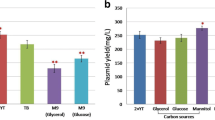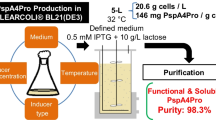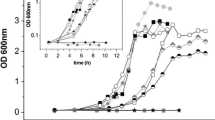Abstract
PsaA, a candidate antigen for a vaccine against pneumonia, is well-conserved in all Streptococcus pneumoniae serotypes. A sequence of two-level experimental designs was used to evaluate medium composition and seed conditions to optimize the expression of soluble mature PsaA in E. coli. A face-centered central composite design was first used to evaluate the effects of yeast extract (5 and 23.6 g/L), tryptone (0 and 10 g/L), and glucose (1 and 10 g/L), with replicate experiments at the central point (14.3 g/L yeast extract, 5 g/L tryptone, 5.5 g/L glucose). Next, a central composite design was used to analyze the influence of NaCl concentration (0, 5, and 10 g/L) compared with potassium salts (9.4 g/L K2HPO4/2.2 g/L KH2PO4), and seed growth (7 and 16 h). Tryptone had no significant effect and was removed from the medium. Yeast extract and glucose were optimized at their intermediate concentrations, resulting in an animal-derived material-free culture medium containing 15 g/L yeast extract, 8 g/L glucose, 50 μg/mL kanamycin, and 0.4% glycerol, yielding 1 g/L rPsaA after 16 h induction at 25°C in shake flasks at 200 rpm. All the seed age and salt conditions produced similar yields, indicating that no variation had a statistically significant effect on expression. Instead of growing the seed culture for 16 h (until saturation), the process can be conducted with 7 h seed growth until the exponential phase. These results enhanced the process productivity and reduced costs, with 5 g/L NaCl being used rather than potassium salts.

Similar content being viewed by others
References
Bogaert D, Hermans PWM, Adrian PV, Rümke HC, de Groot R (2004) Pneumococcal vaccines: an update on current strategies. Vaccine 22:2209–2220
Briles DE (2004) Protection of the elderly from pneumococcal pneumonia with a protein-based vaccine? Mech Ageing Dev 125:129–131
Briles DE, Ades E, Paton JC, Sampson JS, Carlone GM, Huebner RC, Virolainen A, Swiatlo E, Hollingshead S (2000) Intranasal immunization of mice with a mixture of the pneumococcal proteins PsaA and PspA is highly protective against nasopharyngeal carriage of Streptococcus pneumoniae. Infect Immun 68:796–800
Chen Y, Xing X-H, Ye F, Kuang Y, Luo M (2007) Production of MBP-HepA fusion protein in recombinant Escherichia coli by optimization of culture medium. Biochem Eng J 34:114–121
Choi JH, Keum KC, Lee SY (2006) Production of recombinant proteins by high cell density culture of Escherichia coli. Chem Eng Sci 61:876–885
Choi WC, Oh BC, Kim HK, Lee ES, Oh TK (2002) Medium optimization for phytase production by recombinant Escherichia coli using statistical experimental design. J Microbiol Biotechnol 12:490–496
De BK, Sampson JS, Ades EW, Huebner RC, Jue DL, Johnson SE, Espina M, Stinson AR, Briles DE, Carlone GM (2000) Purification and characterization of Streptococcus pneumoniae palmitoylated pneumococcal surface adhesin A expressed in Escherichia coli. Vaccine 18:1811–1821
Douce G, Ross K, Cowan G, Ma J, Mitchell TJ (2010) Novel mucosal vaccines generated by genetic conjugation of heterologous proteins to pneumolysin (PLY) from Streptococcus pneumoniae. Vaccine 28:3231–3237
Fontani S, Niccolai A, Kapat A, Olivieri R (2003) Studies on the maximization of recombinant Helicobacter pylori neutrophil-activating protein production in Escherichia coli: application of Taguchi robust design and response surface methodology for process optimization. World J Microbiol Biotechnol 19:711–717
Gor DO, Ding X, Li Q, Schreiber JR, Dubinsky M, Greenspan NS (2002) Enhanced immunogenicity of pneumococcal surface adhesin A by genetic fusion to cytokines and evaluation of protective immunity in mice. Infect Immun 70:5589–5595
Hao DC, Zhu PH, Yang SL, Yang L (2006) Optimization of recombinant cytochrome P450 2C9 protein production in Escherichia coli DH5α by statistically-based experimental design. World J Microbiol Biotechnol 22:1169–1176
Ihssen J, Kowarik M, Dilettoso S, Tanner C, Wacker M, Thöny-Meyer L (2010) Production of glycoprotein vaccines in Escherichia coli. Microb Cell Fact 9:61–73
Islam RS, Tisi D, Levy MS, Lye GJ (2007) Framework for the rapid optimization of soluble protein expression in Escherichia coli combining microscale experiments and statistical experimental design. Biotechnol Prog 23:785–793
Larentis AL, Argondizzo APC, Esteves GS, Jessouron E, Galler R, Medeiros MA (2011) Cloning and optimization of induction conditions for mature PsaA (pneumococcal surface adhesin A) expression in Escherichia coli and recombinant protein stability during long-term storage. Protein Expr Purif 78:38–47
Lavall CB, Andrade ALSS, Pimenta FC, Andrade JG, Oliveira RM, Silva SA, Lima EC, Di Fabio JL, Casagrande ST, Brandileone MCC (2006) Serotypes of carriage and invasive isolates of Streptococcus pneumoniae in Brazilian children in the era of pneumococcal vaccines. Clin Microbiol Infect 12:50–55
Lee KM, Rhee CH, Kang CK, Kim JH (2006) Sequential and simultaneous statistical optimization by dynamic design of experiment for peptide overexpression in recombinant Escherichia coli. Appl Biochem Biotechnol 135:59–80
Lee SY (1996) High cell-density culture of Escherichia coli. Trends Biotechnol 14:98–105
Manderson D, Dempster R, Chisti Y (2006) A recombinant vaccine against hydatidosis: production of the antigen in Escherichia coli. J Ind Microbiol Biotechnol 33:173–182
Niccolai A, Fontani S, Kapat A, Olivieri R (2003) Maximization of recombinant Helicobacter pylori neutrophil activating protein production in Escherichia coli: improvement of a chemically defined medium using response surface methodology. FEMS Microbiol Lett 221:257–262
Nikerel İE, Öner E, Kirdar B, Yildirim R (2006) Optimization of medium composition for biomass production of recombinant Escherichia coli cells using response surface methodology. Biochem Eng J 32:1–6
Pan H, Xie Z, Bao W, Zhang J (2008) Optimization of culture conditions to enhance cis-epoxysuccinate hydrolase production in Escherichia coli by response surface methodology. Biochem Eng J 42:133–138
Pimenta FC, Miyaji EN, Arêas APM, Oliveira MLS, de Andrade ALSS, Ho PL, Hollingshead SK, Leite LCC (2006) Intranasal immunization with the cholera toxin B subunit-pneumococcal surface antigen A fusion protein induces protection against colonization with Streptococcus pneumoniae and has negligible impact on the nasopharyngeal and oral microbiota of mice. Infect Immun 74:4939–4944
Pistorino M, Pfeifer BA (2009) Efficient experimental design and micro-scale medium enhancement of 6-deoxyerythronolide B production through Escherichia coli. Biotechnol Prog 25:1364–1371
Rajam G, Anderton JM, Carlone GM, Sampson JS, Ades EW (2008) Pneumococcal surface adhesin A (PsaA): a review. Crit Rev Microbiol 34:131–142
Rodrigues MI, Iemma AF (2009) Planejamento de experimentos e otimização de processos, 2nd edn. Casa do Pão Editora, Campinas
Seo JY, Seong SY, Ahn BY, Kwon IC, Chung H, Jeong SY (2002) Cross-protective immunity of mice induced by oral immunization with pneumococcal surface adhesin A encapsulated in microspheres. Infect Immun 70:1143–1149
Sunitha K, Kim Y-O, Lee J-K, Oh T-K (2000) Statistical optimization of seed and induction conditions to enhance phytase production by recombinant Escherichia coli. Biochem Eng J 5:51–56
Tai SS (2006) Streptococcus pneumoniae protein vaccine candidates: properties, activities and animal studies. Crit Rev Microbiol 32:139–153
Volontè F, Marinelli F, Gastaldo L, Sacchi S, Pilone MS, Pollegioni L, Molla G (2008) Optimization of glutaryl-7-aminocephalosporanic acid acylase expression in E. coli. Protein Expr Purif 61:131–137
Zhao J, Wang Y, Chu J, Zhang S, Zhuang Y, Yuan Z (2008) Statistical optimization of medium for the production of pyruvate oxidase by the recombinant Escherichia coli. J Ind Microbiol Biotechnol 35:257–262
Acknowledgments
Bio-Manguinhos, PDTIS (Programa de Desenvolvimento Tecnológico de Insumos para Saúde) and PAPES V (Programa Estratégico de Apoio à Pesquisa em Saúde) from Fundação Oswaldo Cruz (Fiocruz) supported this work. We thank Sinéa Mendes de Andrade MSc, Cláudia Maria da Conceição MSc, and Dr. Filipe Soares Quirino da Silva (INCQS/Fiocruz) for the use of the densitometer, Dr. Ana Carolina Andrade de Góes (Bio-Manguinhos/Fiocruz) for help in purification analysis, and Prof. Dr. Tito Lívio Moitinho Alves (COPPE/UFRJ) for fruitful discussions.
Author information
Authors and Affiliations
Corresponding author
Rights and permissions
About this article
Cite this article
Larentis, A.L., Nicolau, J.F.M.Q., Argondizzo, A.P.C. et al. Optimization of medium formulation and seed conditions for expression of mature PsaA (pneumococcal surface adhesin A) in Escherichia coli using a sequential experimental design strategy and response surface methodology. J Ind Microbiol Biotechnol 39, 897–908 (2012). https://doi.org/10.1007/s10295-012-1099-8
Received:
Accepted:
Published:
Issue Date:
DOI: https://doi.org/10.1007/s10295-012-1099-8




